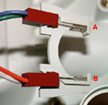- Location
- Los Angeles
I want to disable the "drip sensors" on my perisaltic feeder pump. After opening the pump unit, I found two sensors located close to where the drip capsule is at. I'm guessing they are photo transistors(?). The sensors face each other with the drip capsule in the middle. The sesors notify the unit if there are actual liquid passing through. Each sensor has two legs. One longer than the other, I'm assuming its like cathode and anode ends on LEDs. Each leg has a wire connected to it...so there are a total of 4 wires. The four wires then connect to the main electronic circuit board.
I don't know if there is an easy way to bypass the sensors (ie. close each pair of wires with resistor?).
Any help is greatly appreciated.
I don't know if there is an easy way to bypass the sensors (ie. close each pair of wires with resistor?).
Any help is greatly appreciated.









